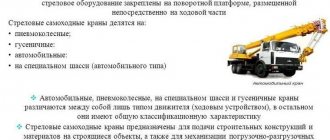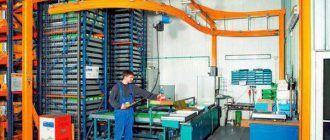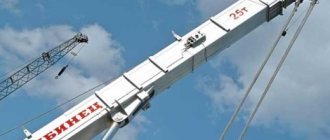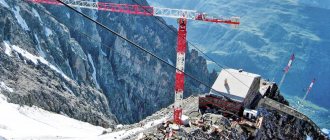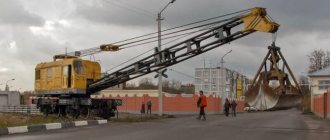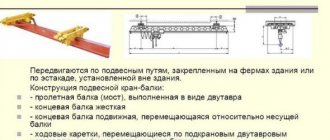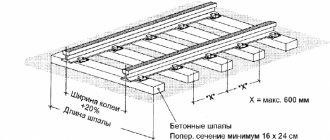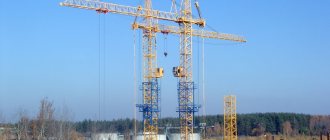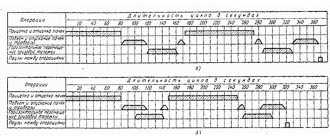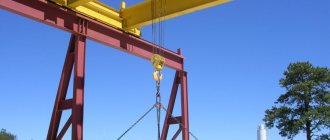Truck cranes are the most popular and in demand among the variety of modern special equipment used on construction sites. These self-propelled, durable and powerful machines easily lift various loads and move them over the required distances. Thanks to this feature, they are used in the construction, repair and reconstruction of buildings, the construction of bridges and highways, as well as the installation of street lighting, advertising and decorative urban structures. In order to select the most correct type and model of this unit to perform certain jobs, you need to understand what types of cranes are offered by manufacturers. Let us consider in detail the classification of cranes, as well as their purpose, most important features and advantages.
General information and parameters
Modern lifting equipment began to be produced in Russia in 1936. When large-scale construction of buildings and structures from large prefabricated reinforced concrete blocks began. To significantly speed up the process of building construction, the method of installation “from wheels” has become widely used. Thanks to this, over several decades, more than 80 modifications of cargo cranes have appeared.
Factories throughout the country were producing this equipment. However, the reorganization of construction methods proceeded faster than the improvement of the designs of lifting mechanisms. Therefore, VNII Stroymash decided to create and implement a unified state standard. The production of machines according to the new rules made it possible to update, improve and unify the existing fleet of construction machines.
Today, lifting equipment forms a whole group of industrial equipment designed to move cargo in space. The characteristics of modern lifting cranes meet all the requirements of organizational and technological solutions at construction sites. Technological maps and work plans take into account the operating parameters of lifting mechanisms interconnected with the features of the building being constructed. These include:
- The boom radius is the horizontal distance in meters from the rotating crane structure to the axis of the hook suspension. It is measured without a load or in the position of the crane on a horizontal platform and is indicated by the symbol L. The boom radius without an installed load is called installation, and with a load - shunting. The boom reach distance must ensure safe construction work, including in conditions limited to residential buildings. It is necessary to know this parameter in order to calculate the boundaries of the dangerous zone of the crane operation and the boundaries of a possible fall of the load.
- Load capacity is the maximum weight of the transported load that the mechanism is designed to lift. This value also includes the weight of the grab, traverse and slings - removable devices for gripping the load. The dependence of the lifting capacity (Q) on the boom radius (L) and its length is expressed graphically in the form of a diagram on which the key points and properties of the lifting capacity are indicated. Determining this characteristic is necessary when selecting the type and model of machines for construction work. In this case, the weight of the heaviest structural element of the building being erected is taken into account.
- Lifting height (H) is the distance from the starting point of parking to the top point of the load-handling device in the working position.
- Load moment (M) - represents the product of the reach of the load-handling element and the load-carrying capacity. The resulting value takes into account two key characteristics, so it is used to indicate the main general parameter of the crane.
- Track (K) - the distance measured between the axes of the supporting surfaces of the running parts of the machine. This characteristic is necessary for the design and designation of the working path of the machine in the work project.
- Speed of lifting and landing and moving weight in operating mode (V). Functionality and speed parameters are taken into account during installation and laying of structures.
- Performance. It is measured in the number of units or mass of materials that a machine assembles or moves during a certain cycle in a period of time.
- Total weight of the unit. The value of the mass of the crane with ballast, mounting and transport devices and counterweight. It is taken into account when selecting a crane for specific soil parameters.
The purpose of cranes is to work with loads not only on a construction site, but also in industrial production conditions. Spatial movement of large structures and materials is the main functionality of these machines.
Advantages and disadvantages of products
The ball crane has the following advantages:
- a light weight;
- small construction length;
- low hydraulic resistance of the working substance;
- Possibility of installation in any position in space;
- excellent value for money;
- high-quality tightness;
The disadvantages of the products include:
- high amount of torque required to turn the handle;
- the appearance of water hammer in the water supply when the tap opens quickly;
- the need to open and close the tap regularly (at least once a week) so that the ball does not “stick”;
- poor applicability of the most common products with fluoroplastic seals at operating temperatures above 150C.
Brass ball valves - features
Advantages:
- wide selection of models from different manufacturers;
- affordable price;
- high delivery speed;
- performance characteristics optimal for water and gas;
- resistance to mechanical stress.
Flaws:
- a small selection of ball valve diameters - usually produced with DN 8-100mm;
- unstable operation if the operating temperature exceeds 200C;
- inability to consistently use the valve in pipelines with petroleum products;
- no welded model.
Steel ball valves - features
These taps are made of carbon steel (marked 20 or 25), which are widely used in housing and communal services and industry.
Advantages:
- low cost;
- wide selection of models from different manufacturers;
- high delivery speed;
- performance characteristics optimal for water and gas;
- a wide range of
- resistance to mechanical stress.
Disadvantages of steel cranes:
- difficulties may arise with prolonged use of cold water supply systems;
- inability to use products in mildly aggressive environments;
- instability at operating temperatures below -40 degrees C;
General features of construction cranes
The variety of architectural forms and design solutions of construction projects has led to the emergence of lifting machines of various modifications. But the technological scheme of any lifting crane retains a number of basic mechanisms:
- A supporting structure consisting of welded metal elements (trusses) and steel ropes. It is made of angle steel and has a lattice structure of rectangular cross-section. The hinged joints of the supports allow you to change the lifting height of the crane. The structure is supported on the platform in the front part by hinges, and on the ballast side by bolts. This fastening allows the crane to rotate. The supporting structure has a number of mechanical, hydraulic and electrical units.
- Lifting tool - winch or hoist. Driven by an electric motor and built-in planetary gear. It has several speed characteristics for lifting and lowering and is attached to a load-handling device.
- Load-handling device. The equipment can be equipped with a hook, bucket, slings and other devices, in accordance with the work flow chart.
- Controls for actuators and systems. Located in the driver's cabin, they are designed to regulate and monitor the operation of the machine. Remote control sensors are installed on the trolley and winch drums and determine the point of movement of the crane.
The main working parts of the lifting machine act as a load-bearing frame. It takes the load from hanging elements and systems. Therefore, the design of the crane meets the requirements of reliability and safety in accordance with the main purpose of the equipment.
Differences between a faucet and a valve
The valves and valves are characterized by high tightness, both designs are suitable for high pressure pipes.
A valve is a locking mechanism that involves blocking the water flow through a partition. Constipation allows you not only to block the flow, but also to regulate its intensity. The partition is made in the form of a sheet, board or wedge. Some designs include two or more partitions that slide apart to supply water.
The main differences between the two types of structures are:
- The presence of a closing element at the valve, which moves perpendicular to the flow up or down, or from side to side. The main element of the faucet is the valve, in which a channel is made. The shutter can rotate around its axis. When the channel is placed at a slight angle or parallel to the flow, the intensity of the liquid supply increases, and when placed perpendicularly, the water flow is blocked.
- Frequent use of the valve leads to rapid wear of the device. The crane is characterized by higher wear resistance.
- To accommodate the moving part of the partition, there is a need for additional space outside the pipeline cross-section. When installing the faucet, space is required only for the adjusting elements.
- The valve is used as a locking element. The tap is used to adjust the intensity.
The water valve is used as a closure mechanism.
Valves are not used as elements of household models.
Working principle of a crane
The crane, being the main lifting force in construction, serves to automate the work process of constructing industrial and private construction projects. The principle of operation is based on the movement of materials by changing the parameters of the boom reach and height. The operation of the crane consists of the main operations that make up the work cycle:
- capture;
- lifting and moving materials and structures to the place of installation or storage;
- lowering;
- disconnecting the load from the load-handling device;
- returning the mechanism to its working position to repeat the cycle.
Ensuring the execution of work at the facility occurs through a cyclical combination of operations in a certain sequence.
Characteristics and material of manufacture
In the production of die-cast cases, an alloy of aluminum and silicon is often used.
Various models are made from the following materials:
- bronze;
- brass (often decorated with galvanic coating);
- copper;
- cast iron;
- alloy steel;
- plastic (polypropylene or polyethylene).
The classification of water supply devices is standardized by GOSTs 19681-94 and 25809-96. Characteristics depend on several parameters:
- Bandwidth. There are 3 groups of mixers with parameters 40-50%, 70-80%, 90-100%.
- Tightness class, permissible pressure. Class 1 provides pressure up to 1 MPa, class 2 – up to 0.63 MPa.
- Noise level. Mixers are divided into 3 groups: up to 20 dB, 20-30 dB and more than 30 dB.
- Temperature conditions. Taps are available for cold and hot water (up to 75°C).
Each product is accompanied by technical documentation, which indicates the parameters.
Types of lifting cranes
Types and types of lifting cranes are defined in GOST 27555-87 (ISO 4306-1-85) Lifting cranes. This standard establishes a number of terms and definitions in the field of crane construction. It applies to all lifting machines, systematizes types and provides definitions of devices in accordance with their design and parameters.
By load capacity
The classification of equipment by load capacity is not presented in GOST. It is related to the areas of application of lifting equipment in production.
- With low load capacity from 1 to 3 tons. The machines are compact and lightweight. With a lifting height of the lifting element of up to 5 m, they are easily transported and convenient for small construction sites.
- With medium load capacity. They are used in the construction of mid-rise buildings. They lift loads weighing up to 50 tons to a height of up to 25 meters, thanks to a telescopic retractable boom.
- With high load capacity. Capable of moving loads weighing 250 tons. They are stationary installations used in industrial enterprises, workshops, as well as in long-term construction conditions.
Lifting cranes are designed to make it easier to work with large loads of different weights. Manufacturers produce a large number of modifications of this equipment, but all samples work on a similar principle.
By design
Table 1 in GOST 27555-87 includes a classification of cranes by design. This group includes overhead cranes, which are divided into supporting and suspended. Their distinctive feature is the design of the main and end beams, which in cross section have the appearance of a bridge. The support crane has a rigid support on the crane runway, located on the crane beam. The bridge is connected to an overhead crane track. Such units are installed in industrial workshops, overpasses and depots. They are designed for transporting materials during installation work.
A gantry crane in cross section looks like a four-post portal, formed as a result of supporting the bridge on two support posts. The main advantage of this lifting mechanism is the ability to move cargo both along and across the service area.
If possible, move
There are stationary units that are mounted on a fixed base. Due to their low mobility, they are used extremely rarely. In construction site conditions, mobile or attached machines are more often used. The mobile crane is mounted on rails and can move along the building or work area. The attached model is used in cases where it is necessary to increase the strength and stability of the equipment. It is fixed to the structure being built. Such lifting units are equipped with a special mechanism for movement during work and transportation.
This group also includes a crawler jib crane. Thanks to low ground pressure, it has high maneuverability and maneuverability. The support contour in the form of tracked cargo carts with a lifting winch allows the machine to move in work areas with a load on a hook, the weight of which can reach 80% of the total lifting capacity. Tracked units differ:
- by type of undercarriage - regular or enlarged track surface;
- by type of drive - electric drive from its own or external network;
- according to the parameters of the working equipment - boom and turret-boom modification.
Mobility plays a key role in equipment selection. The running gear of this machine has from two to five axles and four drive wheels. According to the design of the suspension, the mechanisms are:
- with a rigid suspension in the form of a rope - beam system;
- with hydraulic cylinders.
Pneumatic tire models are popular due to their maneuverability and ability to work in cramped urban conditions.
A crane is a universal equipment for moving large cargo. It is used in construction and industry to increase productivity and efficiency. The work cycle of this lifting machine involves performing main and auxiliary operations in a specific order, which helps to provide service to large construction sites and production workshops. The development of designs and the creation of various modifications of this equipment makes it possible to productively use it in conditions of limited urban space.
Alloy steel products cold resistant faucet
Such taps are made of alloy steel (usually grade 09G2S) and are used at temperatures below -60C. In terms of other characteristics, the products are identical to steel ones.
Stainless steel ball valve
The product is made of stainless steel (grade 12Х18Н10Т and similar) and is widely used in industry.
Key benefits:
- wide range of working environments;
- applicability at temperatures below -60C.
Flaws:
- high price;
- limited selection of models - mainly on sale with DN 8-300 mm;
- long-term delivery of most products.
Cast iron tap
A cast iron ball valve is more expensive because steel is mass produced. That is why most manufacturers refused to produce cast iron products, and since 2010, cast iron taps have been produced by a single manufacturer in our country.
Polypropylene tap
Plastic products are usually made from polypropylene and are installed on plastic pipes.
Key advantages of polypropylene taps:
- durability - products last a long time like brass ones;
- affordable price;
- a light weight.
The key disadvantage of the products is that they can only be installed on plastic pipes.
